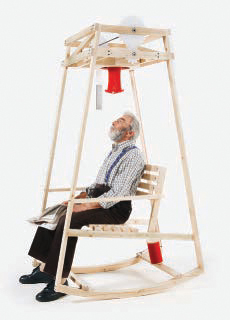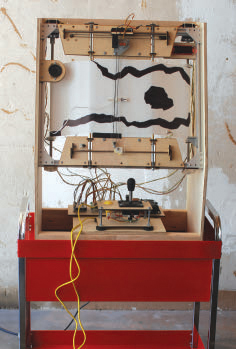MADE ON EARTH
#madeonearth
The world of backyard technology

Gregory Hayes
ALTARED REALITY
On a trip to Mexico, artist Chad Meserve fell for the playful and quirky skeleton dioramas of the Día de los Muertos ofrenda — a traditional altar with offerings for the deceased. Once home again in Burbank, Calif., he began to extrapolate the ofrenda’s post-apocalyptic descendents: scenes starring robots in place of skeletons. This series of miniature sculpted figures depicting day-to-day human activities is Day Of The Robot.
After a normal day’s work immersed in other filmmakers’ worlds, Meserve retreats to the workbench to create his own. Starting each new scene from scratch, he makes every figure, costume, and prop by hand.
Lamenting that the classic diorama has become “an art form marginalized by mandatory school projects,” he knew his debut scene had to be something universally recognizable and accessible, and so he created the Robot Nativity. After receiving a rare positive Regretsy nod, that first Nativity sold almost immediately, and things took off. After that, “I focused on everyday human moments. I imagine all these robots stuck in the world we created, the world they took from us. They didn’t count on needing meter maids and bicycle repairmen. These otherwise autonomous machines wind up enslaved to our inane habits and outdated technology.”
—Gregory Hayes
AGNES THE KNIT BOT
Agnes blinks, looks around, and drops her gaze back to the task at hand — knitting. True to her name, Agnes Roboknit is a humanoid robot that knits on a circular loom, periodically lifting her head to look side to side and blink. Artist and inventor Andy Noyes, who lives in southeast England, explains, “I wanted her to look human from a distance, but obviously be a machine closer up, with metal parts on show.”
DC motors drive her joints, using homemade gears. In fact, almost every part of her body was handmade, including her silicone face and her hands — latex made from plaster casts of a real person. The original plan had her knitting with needles, but after Noyes learned how to knit himself — a necessary step in his design process — he realized a loom would be easier. Agnes debuted at the 2013 Maker Faire U.K.
Why the name Agnes? “To start with it was A.G.N.E.S., and I wanted it to be an acronym as if from the early days of computers. Though I couldn’t think up a good acronym so it just became Agnes,” he recalls. “Also my grandmother, who used to knit — as all grandmothers do, don’t they? — was called Agnes.”
— Laura Cochrane
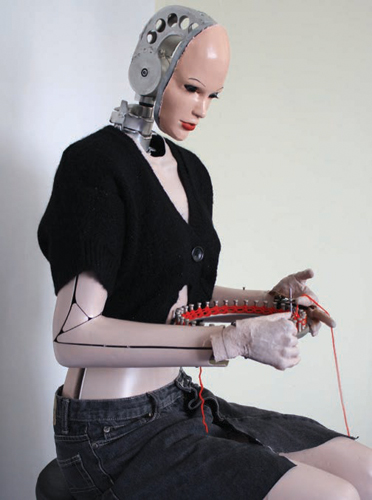
Agnes’ arms contain electric motors salvaged from old desktop printers.

Gerardo Cid
ROBOT BALLERINAS
The geometric frames and Arduino-controlled servos of Brooklyn-based Ricardo Cid’s Robot Ballerinas don’t bear a strong physical resemblance to human ballerinas, but the concept behind them is similar. Cid poses a question: Can writing a piece of code be equivalent to writing a piece of choreography?
—Andrew Salomone
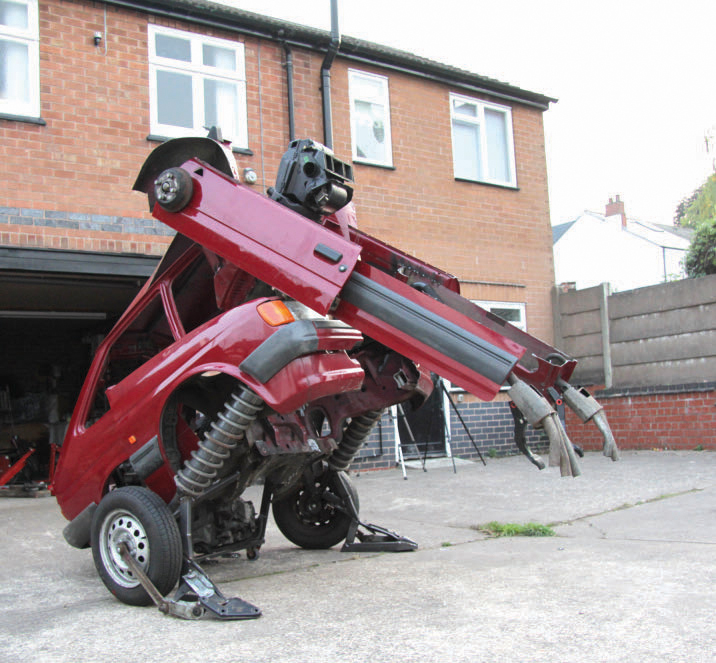


TRANSFORMED: Hetain Patel mutates the humble Ford into a looming 8-foot-tall sculpture with the help of his father, Pravin Patel.
MORE THAN MEETS THE EYE
U.K.-based artist Hetain Patel’s first car was a 1988 Ford Fiesta handed down from his father, Pravin Patel. In his first sculptural work, a collaboration with his father and engineer brother, Pritum Patel, he reconstructs a similar vehicle into an unexpected Transformer-like figure in a comfortable squat.
Patel writes, “This posture is a recurring image in my work and forges a link between the lower classes in India and my immigrant family in the U.K., both of whom sit comfortably this way.”
The build took three months and uses only parts from the Fiesta, with the exception of the springs, which ironically were sourced from a Rolls-Royce. Patel’s father, who converts cars into hearses and limousines, was responsible for the welding, cutting, and advising what was structurally possible.
Patel’s work regularly addresses issues of identity and perception, and Fiesta Transformer is no exception. He explains, “For me, these ‘robots in disguise’ (as per the cartoon’s theme tune) stand as a metaphor for the other, in a fantasy world where they can transform out of a marginal position into one of empowerment. … Unlike the popular toys and films, the car here is not a high-powered sports car or truck transformed into a powerful warrior, but rather a small inexpensive Ford Fiesta.”
—Goli Mohammadi
MAGNIFICENT MAZE
If you visited Maker Faire Bay Area the past two years, you may have happened upon this amazing Big Ball Maze Game by locally based maker David Thomasson. The game gives the defamiliarization treatment to the traditional handheld maze game by making it too big to be handheld and, to give the user a whole new experience, there are a multitude of Arduino-controlled interfaces, including: video game controller, smartphone, body position, brainwave headset, and visual feedback.
—Andrew Salomone

BRICKS FROM THE BEYOND
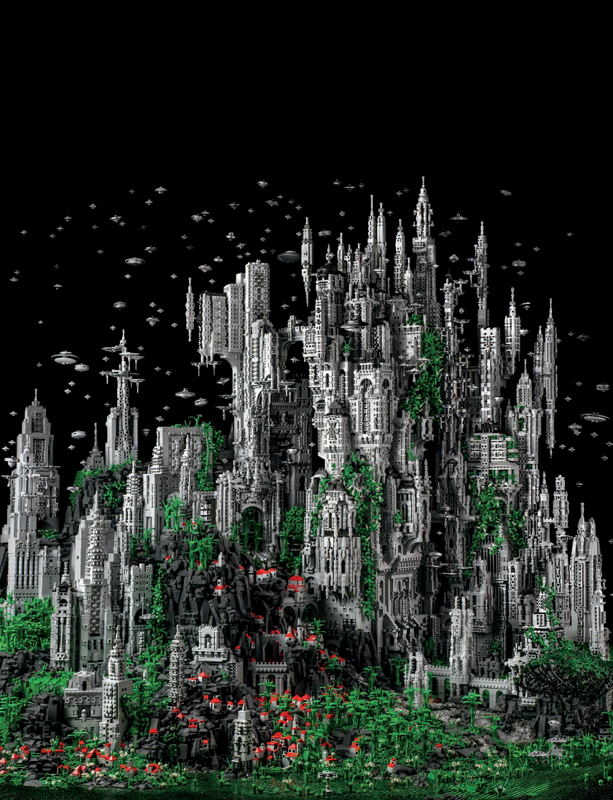
New York-based graphic designer and artist Mike Doyle is a Lego master known for thinking outside the brick. He first caught our attention in 2011 with his beautifully rendered, black-and-white, eerily dilapidated Lego Victorian houses.
His latest piece, titled Contact 1: Millennial Celebration of the Eternal Choir at K’al Yne, Odan, employs more than 200,000 bricks, took over 600 hours to build, and stands 5 feet tall and 6 feet wide. Images of the piece are so unreal that they leave the viewer wondering if they aren’t renderings. Doyle responds, “The project is built and then photographed. 90% of the saucers are connected to the model with black Lego hoses. These mostly disappeared against a black screen.”
Contact 1 is the first in Doyle’s Contact Series, large-scale, sculptural storytelling based around the mythical world of Odan, “celebrating spirituality, peaceful ET contact, and fantastical worlds.” Doyle is currently working on the next piece in the series: The Great Temple of Odan. He navigates Lego like such a lifelong pro, it’s hard to believe he began working with Lego as an alternative art medium merely three years ago. Doyle’s new book, Beautiful Lego, takes an in-depth look at exceptional works born out of the Lego artist community.
— Goli Mohammadi

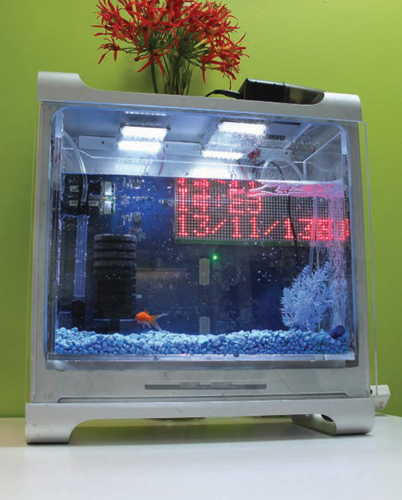
Nemo’s fish tank home is controlled by a Raspberry Pi and an Arduino.
MACQUARIUM
What has your fish tank done for you lately? U.K.-based Hayden Kibble decided to transform an old Mac G5 into a super-smart home for his goldfish, Nemo. After exhibiting it at Manchester Mini Maker Faire in 2012 and getting feedback from fairgoers, he made improvements.
Now, the futuristic fish tank has automatic feeding, timed LED lighting, water depth monitoring, a digital thermometer, an underwater fish-cam, an LCD status display, a servo-controlled filter and bubbles, and best of all, can display your text message on the scrolling matrix display or read it aloud with a computerized male voice. A tidy web interface allows Nemo’s caretaker to monitor the system from afar.
—Laura Cochrane
TURNING TIDES
To make it easier for students to understand the protein folding pathways of polypeptides, scientist Ronald Zuckermann and his colleague at Lawrence Berkeley National Laboratory’s Molecular Foundry, Promita Chakraborty, created Peppytides — physical models of polypeptide chains made of 3D-printed parts, screws, and magnets.
“Although computer graphics provide beautiful 3D representations,” says Zuckermann, “you really lose the sort of tactile feel and the intuitive sense of the flexibility of these chains, which fold into structured proteins, without something you can hold and play with.”
In a hands-on session at a nearby college, “four out of five students were able to fold it,” says Chakraborty. “It’s a big achievement given that the chain is so complex.”
The two are now looking at human-computer interaction. “With some augmented reality-type hardware and software,” says Zuckermann, “you may soon be able to link a Peppytide to a computer so that as you twist and fold it, the computer can be tracking your movements and then use that information to perform calculations or compare its similarities to say, hemoglobin.”
—Laura Kiniry

GIVING NEW LIFE TO A HANGMAN

Relays and multiplexing chips let one small Arduino control dozens of inputs and outputs.
David Elliot
Although the game of hangman has traditionally been played by drawing shapes reminiscent of 0s and 1s to make a stick figure on the gallows, Los Angeles-based artist, hacker, and teacher Chris Reilly has devised a new way to use 0s and 1s to play the game.
Binary Gallows is a handsome contraption consisting of an Arduino-based electromechanical interface outfitted with an eight-button binary keyboard. The player uses these buttons to guess the letters of a word by inputting their binary sequence, using a chart displayed on the interface. Once the player has entered their guess a knife switch is pulled to submit it. Correct guesses are represented by a row of five green light bulbs, which individually light up to represent a letter. Incorrect guesses result in a mechanical buzz. If the player doesn’t guess the word within the allotted number of tries, the loss is signaled by a loud MIDI version of Chopin’s funeral march.
Perhaps a more civilized ending than seeing a representation of a dead man on the gallows, but then again, throwing a knife switch like that does suggest there could be a dead man in an electric chair somewhere.
—Andrew Salomone

